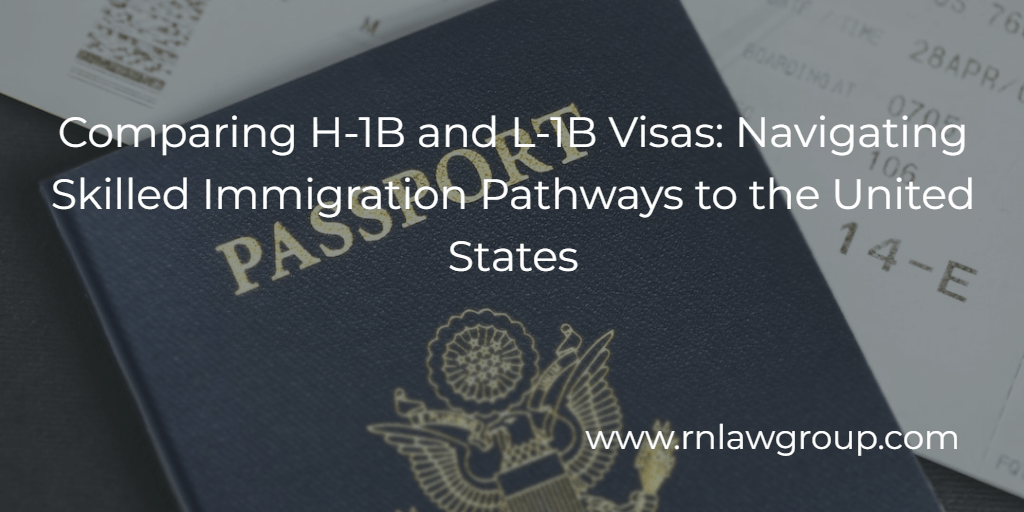
Comparing H-1B and L-1B Visas: Navigating Skilled Immigration Pathways to the United States
Introduction
The United States offers various visa options for skilled foreign workers seeking employment opportunities in the country. Among these, the H-1B visa and the L-1B visa are two prominent choices. Both visas cater to different scenarios and needs, making it essential for prospective immigrants and employers to understand their distinctions and implications. In this article, we will provide a comprehensive comparison of the H-1B and L-1B visas, highlighting their key differences and eligibility criteria.
H-1B Visas: Bridging the Skills Gap
The H-1B visa program was established to address the shortage of skilled workers in the U.S. labor market, enabling employers to hire foreign professionals in specialized occupations. This visa is commonly sought by individuals with specialized knowledge and a bachelor’s degree or higher, making it ideal for professionals in fields such as IT, engineering, healthcare, and finance.
- Eligibility Criteria: To qualify for an H-1B visa, applicants must have a job offer from a U.S. employer in a specialty occupation that requires theoretical and practical expertise. They must possess at least a bachelor’s degree or equivalent in the relevant field. The employer must also demonstrate that the foreign worker’s employment will not adversely affect the wages and working conditions of U.S. workers.
- Duration and Extensions: H-1B visas are typically granted for three years and can be extended for up to six years. After reaching the six-year limit, visa holders must either leave the U.S. or transition to another visa category, such as an employment-based green card. This limited timeframe can create challenges for visa holders seeking permanent residency.
- Dual Intent: One significant advantage of the H-1B visa is its “dual intent” provision. This means that H-1B visa holders can pursue lawful permanent residency (a green card) while maintaining their nonimmigrant status. This offers a path for skilled workers to eventually settle in the U.S. on a permanent basis.
L-1B Visas: Leveraging International Expertise
The L-1B visa, on the other hand, is designed for international companies seeking to transfer employees with specialized knowledge to their U.S. offices. This visa facilitates intra-company transfers and encourages the sharing of expertise across borders.
- Eligibility Criteria: L-1B visa applicants must have been employed by a foreign company for at least one year within the preceding three years in a position that involves specialized knowledge. The applicant’s expertise could pertain to proprietary products, services, techniques, or management processes unique to the company. Unlike the H-1B, the L-1B visa does not require a specific educational qualification.
- Duration and Extensions: L-1B visas are initially granted for up to three years, with extensions possible for a maximum of five years. Unlike the H-1B visa, there is no strict overall limit on the duration of stay. However, the total time spent on L-1B status and L-1A status (for managers and executives) combined cannot exceed a total of seven years.
- Intra-Company Transfer: The L-1B visa’s primary purpose is to facilitate the transfer of employees within the same multinational company. This means that the applicant’s foreign employer and U.S. employer must have a qualifying relationship, such as a parent, subsidiary, affiliate, or branch relationship. This provision encourages cross-border collaboration and knowledge sharing within global corporations.
Comparing the Two Visas
- Specialized Knowledge vs. Specialty Occupation: The primary distinction between H-1B and L-1B visas lies in their focus. H-1B visas are intended for individuals with specialized skills working in U.S. specialty occupations, while L-1B visas target employees transferring within multinational companies who possess specialized knowledge.
- Educational Requirements: H-1B visas require applicants to have at least a bachelor’s degree or its equivalent, whereas L-1B visas do not have a specific educational requirement. This makes the L-1B visa accessible to skilled professionals who may have gained their expertise through practical experience rather than formal education.
- Employer Relationship: While both visas involve employer sponsorship, the L-1B visa necessitates a qualifying relationship between the foreign and U.S. employers. This connection establishes the basis for the transfer of specialized knowledge within the same corporate entity.
- Duration and Transition to Permanent Residency: H-1B visas are granted for a maximum of six years, after which visa holders must transition to another status, such as a green card. L-1B visa holders can stay for a maximum of five years, and they may also transition to an L-1A visa if they assume a managerial or executive role within the company.
- Dual Intent Provision: The H-1B visa offers a “dual intent” provision that allows visa holders to seek permanent residency without jeopardizing their nonimmigrant status. This is not a feature of the L-1B visa.
Conclusion
The H-1B and L-1B visas serve distinct purposes within the realm of U.S. immigration. The H-1B visa addresses the skills gap by enabling employers to hire foreign professionals in specialty occupations, while the L-1B visa promotes the transfer of specialized knowledge within multinational corporations. Prospective immigrants and employers must carefully evaluate their circumstances and needs to determine which visa aligns with their objectives. Understanding the nuances of the H-1B and L-1B visas is essential for making informed decisions that facilitate successful professional journeys in the United States.
By: Felipe Jimenez
Felipe Jimenez is an Associate Attorney at Reddy Neumann Brown PC He works in the H-1B Department where he assists clients through all phases of the non-immigrant visa process.
Reddy Neumann Brown PC has been serving the business community for over 20 years and is Houston’s largest immigration law firm focused solely on US. Employment-based immigration. We work with both employers and their employees, helping them navigate the immigration process quickly and cost-effectively.
Top of Form

